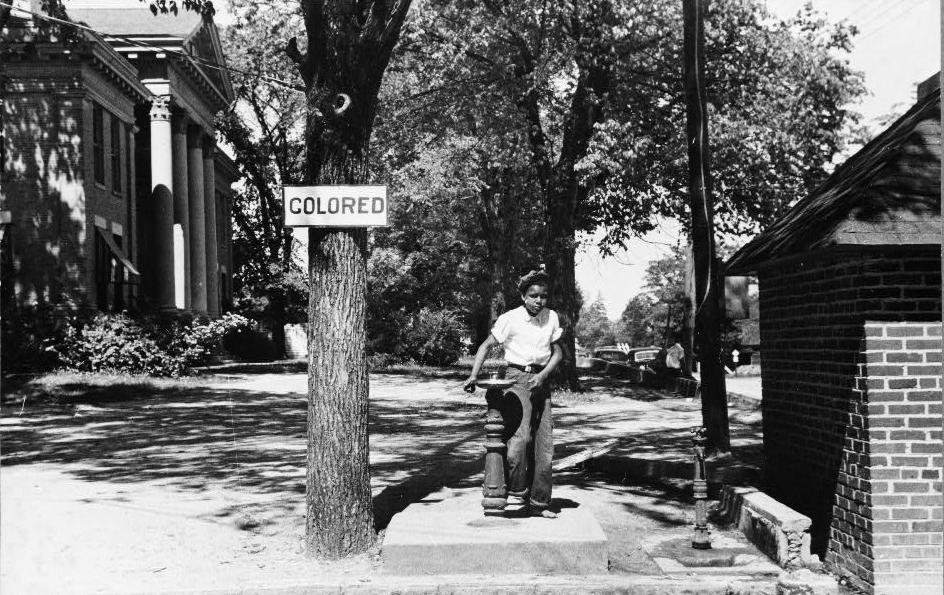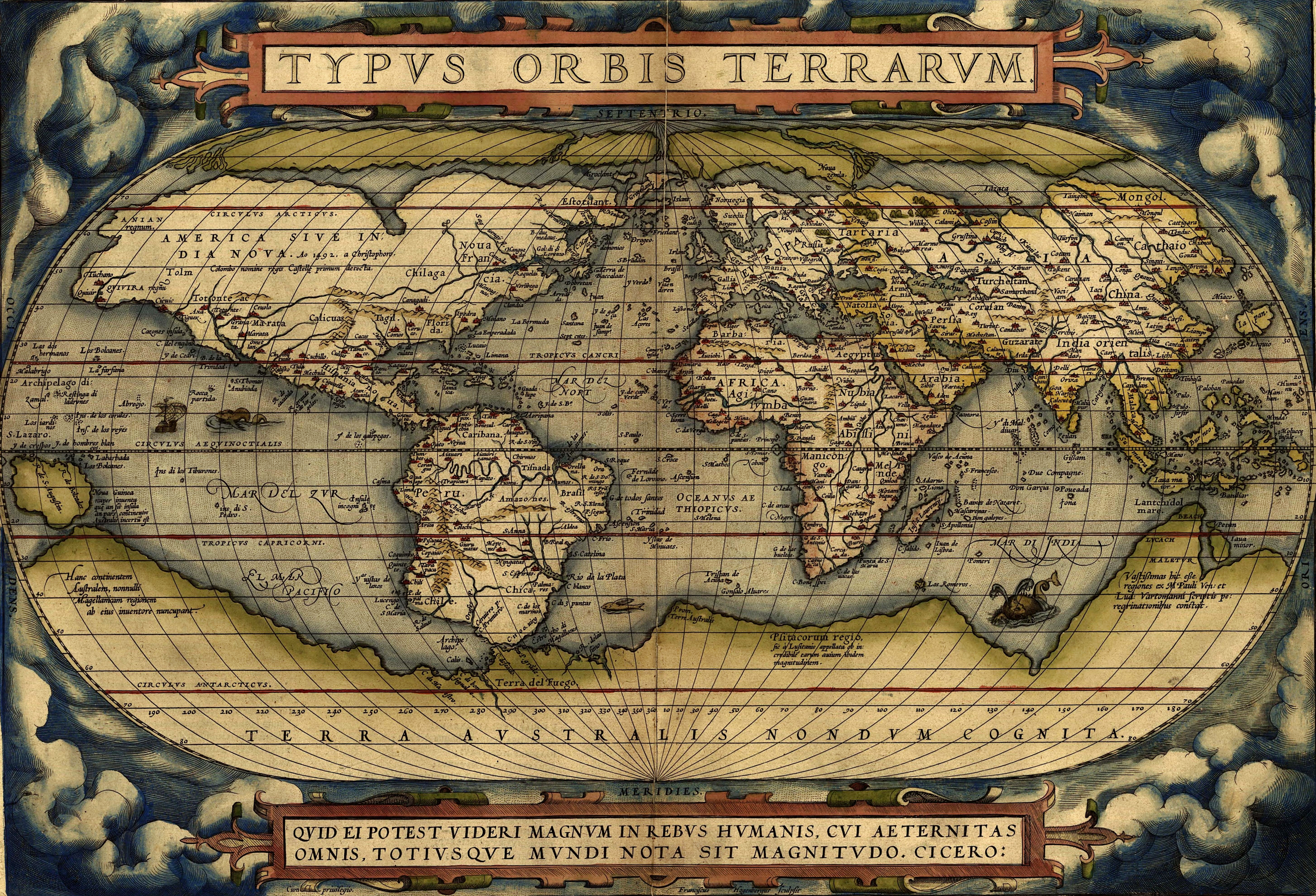
Jim Crow Era Segregated Drinking Fountain
County courthouse lawn, Halifax, North Carolina, 1938
Topics on the Page
Black Codes & Jim Crow Laws
Examples and Consequences
Juan Crow Laws and Jovita Idar
Plessy v. Ferguson (1896)
Green Book
Learning Plans and Slave Narratives
 CROSS-LINKS:
CROSS-LINKS:
 Text of the 15th Amendment to the Constitution
Text of the 15th Amendment to the Constitution
Jim Crow laws were oppressive laws and policies instituted by white southerners in an attempt to restrict the rights and opportunities of African Americans.
- Jim Crow laws focused on segregating blacks and whites, with whites maintaining access to institutions of power and nicer facilities.
- Whites in the South were unaccustomed to living side by side with African Americans who they could no longer legally enslave. Also, they were not accustomed, nor willing, to compete with them economically.
- Jim Crow, then, was a way for Whites to maintain some level of economic and social control over African Americans despite the abolition of slavery.
- Jim Crow laws increased after Plessy v. Ferguson (See below).
Jim Crow Laws started in 1876 and lasted all the way until 1965. They allowed segregation on the basis of "separate but equal" even though that was rarely the case. The remaining Jim Crow laws were eradicated in the "Civil Rights Act of 1964" and the "Voting Rights Act of 1965".
Black Codes & Jim Crow Laws
Examples of Black Codes in the South during the Jim Crow Era*
1.) Race was defined by blood; the presence of any amount of black blood made one black.
2.) Prohibited interracial marriage
3.) Public facilities were segregated
4.) Employment was required of all freedmen; violators faced vagrancy charges
5.) Freedman could not assemble together without a white person
6.) Literacy was prohibited for freedman
7.) Freedman could not own guns or any other weapons
8.) Freedmen couldn’t obtain certain jobs (e.g., shopkeeper, mechanic, etc.) without paying for a license
9.) Freedmen were assumed to be agricultural workers and their duties and hours were tightly regulated
10.) Strict voting regulations (e.g., literacy tests)
11.) Prohibited from owning property
12.) Violators of these laws were subject to being whipped or branded
*many of these codes were enforced in the North as well, however, southern black codes are often categorized as more restrictive and more plentiful than northern ones
The Rise and Fall of Jim Crow Timeline
Here is a timeline of the Jim Crow Laws from 1870 to 1959.
Jim Crow Era
 Click here for an interactive map showing Jim Crow laws by state.
Click here for an interactive map showing Jim Crow laws by state.
Click here for an interactive website for students.
Before the Jim Crow laws were the Black Codes, created by White southerners to curtail the freedoms of former slaves. These regulations forced African Americans into agricultural labor and domestic work. Codes dictated the hours of labor, duties, and behavior.
- In some places, Blacks could not enter a town without permission.
 Click here for a Mississippi Black Code document (1866). Go here for Louisiana Black Code document (1865).
Click here for a Mississippi Black Code document (1866). Go here for Louisiana Black Code document (1865).
- Click here for more information about Jim Crow laws.
- Click Here for personal narratives about the fight against Jim Crow laws
 Worse than Slavery: Parchman Farm and the Ordeal of Jim Crow Justice by David M. Oshinsky, a book detailing lives of African Americans during the Jim Crow era.
Worse than Slavery: Parchman Farm and the Ordeal of Jim Crow Justice by David M. Oshinsky, a book detailing lives of African Americans during the Jim Crow era.
Examples of Consequences of Black Codes/Jim Crow Laws on African Americans' Freedom & Progression
- Because Freedman were prohibited from learning to read and write, their ability to get more influential, higher paying jobs, and consequently, move up on the social latter, was hindered
- Similarly, the literacy prohibition made literacy tests (a requirement for Freedman to pass if they wanted to vote) became near impossible to complete, and therefore, hindered African Americans' ability to vote
- Segregation of public facilities reinforced the idea that whites and blacks are inherently different and that African Americans were second-class citizens comparatively (oftentimes black facilities were of far lower quality than white ones)
- Prohibition on owning property meant that Freedman would have to sharecrop from white employers (Crop-Lien System), which inherently controlled their ability to progress economically and gave power back to whites (sharecropping and the Crop-Lien System very much resembled enslavement)
- Prohibition on gun/weapon ownership for Freedman hindered their ability to protect themselves and their families which was crucial during the Jim Crow Era, as the African American hate crimes were extremely prevalent
- Prohibition on African American gatherings without white presences hindered their ability to plan protests, practice religion, or just create a close-knit community without white intervention
- Limitations, whether financial or social, on African American employment opportunities meant they could not compete with whites economically and were unable to secure government positions that would allow them to protest unjust laws (e.g., Black Codes)
More Sources on Black Codes and Their Implications on African Americans
Black Codes (Video): https://www.youtube.com/watch?v=HvWVX84RBt4
Slavery By Another Name: The Origins of Black Codes (Video Series): https://www.pbs.org/video/slavery-another-name-origins-black-codes/
Black Code and Jim Crow Law Examples (Article): https://sites.google.com/a/email.cpcc.edu/black-codes-and-jim-crow/black-code-and-jim-crow-law-examples
Juan Crow Laws
What were Juan Crow Laws? A term used to describe historical and contemporary discrimination against Mexican Americans.
Overview of Juan Crow laws from Wikipedia
The Texas Rangers Killed Hundreds of Hispanic Americans during the Mexican Revolution. Texas Public Radio (January 29, 2016).

 Jovita Idar who opposed Juan Crow laws and fought for Mexican American Rights.
Jovita Idar who opposed Juan Crow laws and fought for Mexican American Rights.
 Plessy vs. Ferguson
Plessy vs. Ferguson
Plessy v. Ferguson was a landmark 1896 U.S. Supreme Court decision that upheld the constitutionality of racial segregation under the “separate but equal” doctrine.
- The case stemmed from an 1892 incident in which African American train passenger Homer Plessy refused to sit in a car for blacks.
- Rejecting Plessy’s argument that his constitutional rights were violated, the Supreme Court ruled that a law that “implies merely a legal distinction” between whites and blacks was not unconstitutional.
-
In declaring separate-but-equal facilities constitutional on intrastate railroads, the Court ruled that the protections of 14th Amendment applied only to political and civil rights (like voting and jury service), not “social rights” (sitting in the railroad car of your choice).
-
Source
 Green Book (2018)
Green Book (2018)
Summary: Dr Don Shirley is a world-class African-American pianist, who is about to embark on a concert tour in the Deep South in 1962. In need of a driver and protection, Shirley recruits Tony Lip, a tough-talking bouncer from an Italian-American neighborhood in the Bronx. Despite their differences, the two men soon develop an unexpected bond while confronting racism and danger in an era of segregation.
- This could be a good resource to show the students to see this movie, while it is a Hollywood production it is a nice change up from factual or documentaries.
 A possible lesson plan could have them write a summary on their thoughts about the film. Another activity could be the students writing their own screen play for a scene or a movie to depict the the time period.
A possible lesson plan could have them write a summary on their thoughts about the film. Another activity could be the students writing their own screen play for a scene or a movie to depict the the time period.
- They could also change a scene of the movie to make it more factual.
Source: http://www.blckdmnds.com/history-school-segregation-protest
 Learning Plans for the Jim Crow Era
Learning Plans for the Jim Crow Era
 Born in Slavery: Slave Narratives from the Federal Writers' Project, 1936-1938
Born in Slavery: Slave Narratives from the Federal Writers' Project, 1936-1938
Comments (0)
You don't have permission to comment on this page.